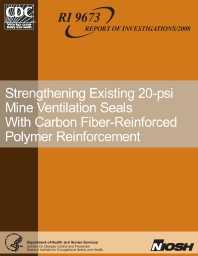Mining Publication: Strengthening Existing 20-psi Mine Ventilation Seals With Carbon Fiber-Reinforced Polymer Reinforcement
Original creation date: January 2008
The National Mining Association and the Mine Safety and Health Administration requested that the National Institute for Occupational Safety and Health (NIOSH) conduct full-scale evaluations of a recently developed carbon fiber-reinforced polymer (CFRP) reinforcement technique for upgrading existing mine ventilation seals to withstand an explosion pressure of 50 psi or greater. The evaluation was conducted in the NIOSH Pittsburgh Research Laboratory Lake Lynn Experimental Mine (LLEM) near Fairchance, PA. The purpose of the evaluation was to determine the blast resistance of the CFRP reinforcement technique, designed to increase the strength of two types of existing 20-psi-rated in situ mine ventilation seals. Two candidate ventilation seals were selected to represent the 20-psi alternative seal designs typical of those used in mines prior to July 2006. Installed within the LLEM were (1) a 4-ft-thick pumpable cementitious foam seal using material with a designed 150- to 200-psi average compressive strength at 28 days and (2) a 24-in-thick, low-density cementitious block seal with a center pilaster and keyed to the floor and ribs. The materials necessary for the CFRP reinforcement technique were then installed on the outby (active) side of each seal, and the seals were subjected to explosion overpressures. Both seals with the CFRP reinforcement retrofit successfully withstood explosion pressures of 60 psi or greater during the full-scale evaluations in the LLEM.
Authors: ES Weiss, SP Harteis
Report of Investigations - January 2008
NIOSHTIC2 Number: 20033132
Pittsburgh, PA: U.S. Department of Health and Human Services, Public Health Service, Centers for Disease Control and Prevention, National Institute for Occupational Safety and Health, DHHS (NIOSH) Publication No. 2008-106, Report of Investigations 9673, 2008 Jan; :1-38
See Also
- Development and Application of Reservoir Models and Artificial Neural Networks for Optimizing Ventilation Air Requirements in Development Mining of Coal Seams
- Evaluating Ventilation Parameters of Three Coal Mine Gobs
- Evaluation of the Relative Importance of Coalbed Reservoir Parameters for Prediction of Methane Inflow Rates During Mining of Longwall Development Entries
- Explosion Pressure Design Criteria for New Seals in U.S. Coal Mines
- Mine Roof Simulator (MRS) Laboratory
- Modeling and Prediction of Ventilation Methane Emissions of U.S. Longwall Mines Using Supervised Artificial Neural Networks
- Modeling the Effect of Seal Leakage on Spontaneous Heating in a Longwall Gob Area
- Progress Toward Improved Engineering of Seals and Sealed Areas of Coal Mines
- Strengthening an Existing 20-PSI Mine Seal with PPG's Polyurea Coated Retrofit
- A Study of Leakage Rates Through Mine Seals in Underground Coal Mines
- Content source: National Institute for Occupational Safety and Health, Mining Program


 ShareCompartir
ShareCompartir
